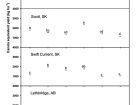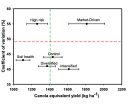
Features
Agronomy
Canola
Pulses
Researching resilient cropping systems
Sustainable crop rotations are at the forefront of research.
August 15, 2022 By Bruce Barker
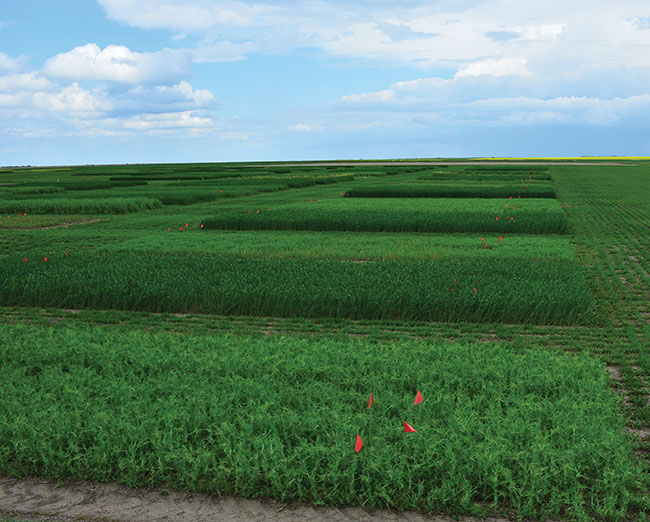 A four-year crop rotation research project is
investigating diversified crop rotations (shown). Photo courtesy of Kui Liu.
A four-year crop rotation research project is
investigating diversified crop rotations (shown). Photo courtesy of Kui Liu.
A canola-wheat rotation has become the most common crop rotation on the Prairies in recent years, driven by high canola returns. But pest, disease and weed resistance issues resulting from this tight rotation means the long term sustainability is questionable. Ongoing research is trying to determine what crop rotations would be most productive, resilient and economical for different ecozones on the Prairies.
“Western Canadian farmers are pressed to increase yield while reducing inputs and environmental impacts on food production. Growers need to determine what crop rotations can help them achieve those goals and remain economically viable,” says Sheri Strydhorst, agronomy research specialist with the Alberta Wheat and Barley Commissions.
The five-year research project was established in 2018 with the final year slated for 2022. The objectives of the research are to (i) increase crop yield, (ii) increase input (nitrogen and precipitation) use efficiency, (iii) reduce pest and disease incidence (iv) improve soil health, (v) mitigate environmental footprint, (vi) improve whole-farm economic outcomes, and (vii) enhance system resiliency. This project is funded through the AgriScience Program as part of the Canadian Agricultural Partnership, a federal, provincial, territorial initiative, along with Alberta Pulse Growers, Western Grains Research Foundation, Alberta Wheat Commission, Sask Canola, Manitoba Crop Alliance and Sask Wheat.
The research is being conducted at Beaverlodge, Lacombe and Lethbridge, Alta.; Swift Current, Scott and Melfort, Sask.; and Carman, Man. The final year will be completed at the Carman site in 2022. Six different rotations are being compared, although the crops grown in those rotations vary by location.
To compare crop productivity across rotations, all crop yields were expressed as Canola Equivalent Yield (CEY). This takes into consideration the price of non-canola crops, the price of canola and the yield of non-canola crops. A detailed economic analysis is expected to be completed during the second half of 2022.
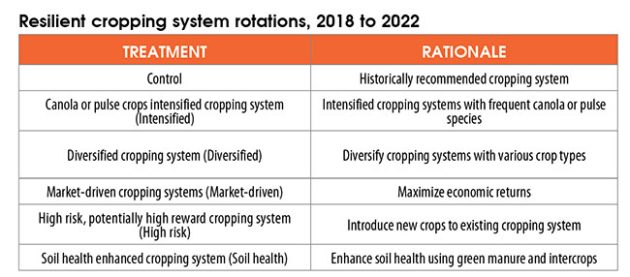
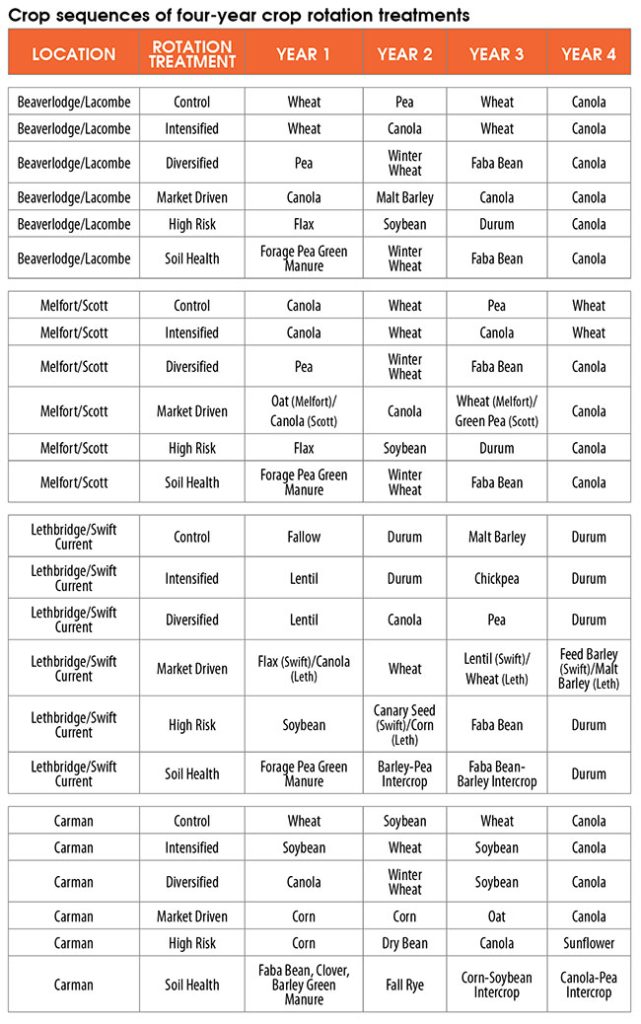
Yield assessed across cropping systems
Kui Liu, a research scientist with AAFC in Swift Current, Sask., says there were significant differences in average system yields, as measured by CEY, across the 27 site-years. The Market-Driven was highest at 2004 kg/ha, which was greater than Intensified (1806 kg/ha) > Control (1630 kg/ha) ≈ Diversified (1603 kg/ha) ≈ High Risk (1517 kg/ha) > Soil Health (1281/kg ha).
The CEY varied by location because of differences in environment and productivity potential. Among the cropping systems, the Control system had the highest annualized CEY at Melfort and the lowest annualized CEY at Swift Current and Lethbridge. No yield in the fallow phase in the Control system explains the lower system yield at Swift Current and Lethbridge, Liu says.
Liu says the Intensified rotation was the most suitable cropping system at Swift Current and can substitute for the control system based on yield and Precipitation Use Efficiency (PUE), grain yield produced per unit of rainfall.
The Diversified was a viable alternative to the control system at Beaverlodge and Lacombe as the two systems had similar yields and PUE and fertilizer use were more efficient in Diversified than control systems.
At Scott and Melfort, Intensified may be an alternative cropping system to the control system as the two systems had similar CEY, Nitrogen Fertilizer Use Efficiency (NFUE), and PUE.
After three years at Carman, the High Risk showed to be the most viable alternative to the control practices as it had a higher yield and PUE than the control practices.
System stability varied
A stability analysis was also conducted to determine the most stable cropping system. It was conducted across the 27 site-years, as there wasn’t enough data points to conduct it on individual sites. A larger coefficient of variation (CV) means a less stable cropping system while a smaller CV means a more stable cropping system.
The Intensified was the most stable cropping system while Market-Driven and High Risk were the least stable systems. The Market-Driven had the highest annualized CEY variation, the highest yield crisis severity in a drought year, and the least stable or most responsive to environmental variations. The lower than average yield and higher than average CV in the High Risk across site-years indicated its vulnerability to changing environmental conditions.
The Intensified had the lowest chance of crop failure under unfavorable conditions and the second to the highest chance of producing maximum yield
under favorable conditions; making Intensified a promising cropping system at least in the short term.
“Overall, the large variation for each cropping system suggested that there is no such single cropping system that can perfectly fit all ecozones. This emphasizes the need to develop site-specific cropping systems according to local soil and weather conditions to fulfil yield potentials and reach the goal of agricultural sustainability,” Liu says.
Strydhorst says to achieve the highest productivity and overall sustainability, the research suggests in high yielding zones, the focus should be on maximizing yields through managing disease and pests. In low yielding zones, the emphasis should be on yield stability through managing abiotic (i.e. temperature, light and water) interactions between crops and the environment.
Liu has applied for funding to carry on the research for another four-year rotation cycle. This will help to show the benefits of longer crop rotations on things like soil health and pest and disease outbreaks.
“A relatively long-term study of two or three four-year rotation cycles is required to evaluate and optimize cropping systems with regard to crop productivity, resource use, pest control, soil health, economic return, and environmental footprint,” Liu says. “Producers might need to take a systems approach when developing and managing their cropping systems. Considering the trade-offs, producers might need to adopt a variety of crop management practices to balance short-term economic returns and long-term sustainability.”
